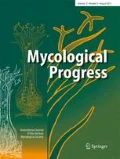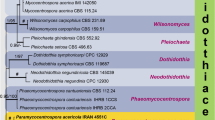Abstract
Mycoceros antennatissimus gen. et sp. nov. is described and illustrated from pollen grains deposited on the bark of Elaeagnus angustifolia and Platanus × acerifolia in Hungary. This fungus is shown to capture pollen grains by its three-dimensional shape. It clearly shows seasonality and appears to be rare. The following factors determine its ecological niche: (1) the availability of fresh Pinaceae pollen grains deposited from the air on the bark of a nearby standing angiosperm tree with (2) water-retaining spongious bark, and (3) rainy weather. Conidia are mainly dispersed by stemflow rainwater, while they hardly become airborne. Direct polymerase chain reaction (PCR) from single conidia made it possible to perform molecular phylogenetic investigation in order to clarify its taxonomic relationship within the Ascomycota.








Similar content being viewed by others
References
Altschul SF, Madden TL, Schäffer AA, Zhang J, Zhang Z, Miller W, Lipman DJ (1997) Gapped BLAST and PSI-BLAST: a new generation of protein database search programs. Nucl Acids Res 25:3389–3402
Bärlocher F, Charette N, Letourneau A, Nikolcheva LG, Sridhar KR (2010) Sequencing DNA extracted from single conidia of aquatic hyphomycetes. Fungal Ecol 3:115–121
Bertini L, Amicucci A, Agostini D, Polidori E, Potenza L, Guidi C, Stocchi V (1999) A new pair of primers designed for amplification of the ITS region in Tuber species. FEMS Microbiol Lett 173:239–245
Cannon PF, Sutton BC (2004) Microfungi on wood and plant debris. In: Mueller GM, Bills GF, Foster MS (eds) Biodiversity of fungi: inventory and monitoring methods. Elsevier Academic Press, New York, pp 217–239
Capella-Gutiérrez S, Silla-Martínez JM, Gabaldón T (2009) trimAl: a tool for automated alignment trimming in large-scale phylogenetic analyses. Bioinformatics 25:1972–1973
Choi Y-W, Hyde KD, Ho WH (1999) Single spore isolation of fungi. Fungal Divers 3:29–38
Chou MC, Preece TF (1968) The effect of pollen grains on infections caused by Botrytis cinerea Fr. Ann Appl Biol 62:11–22
Di-Giovanni F, Kevan PG (1991) Factors affecting pollen dynamics and its importance to pollen contamination: a review. Can J For Res 21:1155–1170
Drechsler C (1961) Some clampless Hyphomycetes predacious on nematodes and rhizopods. Sydowia 15:9–25
Erdtman H (1952) Phenolic and other extraneous components of coniferous heartwoods; their relation to taxonomy. In: Wise LE, Jahn EC (eds) Wood chemistry, vol I. Reinhold, New York, pp 661–688
Fokkema NJ (1968) The influence of pollen on the development of Cladosporium herbarum in the phyllosphere of rye. Neth J Plant Pathol 74:159–165
Fokkema NJ (1971a) Influence of pollen on saprophytic and pathogenic fungi on rye leaves. In: Preece TF, Dickinson CH (eds) Ecology of leaf surface micro-organisms. Academic Press, New York, pp 277–282
Fokkema NJ (1971b) The effect of pollen in the phyllosphere of rye on colonization by saprophytic fungi and on infection by Helminthosporium sativum and other leaf pathogens. Neth J Plant Pathol 77(Suppl 1):1–60
Galili T (2015) dendextend: an R package for visualizing, adjusting and comparing trees of hierarchical clustering. Bioinformatics 31:3718–3720
Gardes M, Bruns TD (1993) ITS primers with enhanced specificity for basidiomycetes—application to the identification of mycorrhizae and rusts. Mol Ecol 2:113–118
Goh T-K (1999) Single-spore isolation using a hand-made glass needle. Fungal Divers 2:47–63
Goldstein S (1960) Degradation of pollen by phycomycetes. Ecology 41:543–545
Gunasekera SA, Webster J (1983) Inhibitors of aquatic and aero-aquatic hyphomycetes in pine and oak wood. Trans Br Mycol Soc 80:121–125
Hirst JM (1952) An automatic volumetric spore trap. Ann Appl Biol 39:257–265
Huang HC, Kokko EG, Erickson RS (1999) Infection of alfalfa pollen by Botrytis cinerea. Bot Bull Acad Sin 40:101–106
Huelsenbeck JP, Ronquist F (2001) MRBAYES: Bayesian inference of phylogenetic trees. Bioinformatics 17:754–755
Hutchison LJ, Barron GL (1997) Parasitism of pollen as a nutritional source for lignicolous Basidiomycota and other fungi. Mycol Res 101:191–194
Ingold CT (1975) An illustrated guide to aquatic and water-borne hyphomycetes (Fungi Imperfecti) with notes on their biology. Freshwater Biol Assoc Sci Publ 30:1–96
Katoh K, Toh H (2008) Recent developments in the MAFFT multiple sequence alignment program. Brief Bioinform 9:286–298
Li Y, Hyde KD, Jeewon R, Cai L, Vijaykrishna D, Zhang K (2005) Phylogenetics and evolution of nematode-trapping fungi (Orbiliales) estimated from nuclear and protein coding genes. Mycologia 97:1034–1046
Magyar D (2008) The tree bark: a natural spore trap. Asp Appl Biol 89:7–16
Magyar D, Merényi Z, Bratek Z, Baral H-O, Marson G (2016a) Lecophagus vermicola sp. nov., a nematophagous hyphomycete with an unusual hunting strategy. Mycol Progr 15:1137–1144
Magyar D, Vass M, Li DW (2016b) Dispersal strategies of microfungi. In: Li DW (ed) Biology of microfungi. Springer International Publishing, pp 315–371
Miller MA, Pfeiffer W, Schwartz T (2010) Creating the CIPRES Science Gateway for inference of large phylogenetic trees. In: Proceedings of the Gateway Computing Environments Workshop (GCE), New Orleans, LA, 14 November 2010, pp 1–8
Nawawi A (1985) Some interesting hyphomycetes from water. Mycotaxon 24:217–226
Nylander JAA (2004) MrModeltest v2. Program distributed by the author. Evolutionary Biology Centre, Uppsala University. Available online at: https://github.com/nylander/MrModeltest2. Accessed 2012
Olivier DL (1978) Retiarius gen. nov.: phyllosphere fungi which capture wind-borne pollen grains. Trans Br Mycol Soc 71:193–201
Prieto M, Wedin M (2013) Dating the diversification of the major lineages of Ascomycota (Fungi). PLoS One 8:e65576
R Core Team (2016) R: A language and environment for statistical computing. R Foundation for Statistical Computing, Vienna, Austria. Home page at: https://www.R-project.org/
Rambaut A. (2009) FigTree, ver. 1.3.1. Available online at: http://tree.bio.ed.ac.uk/software/figtree/
Révay Á, Gönczöl J (2011) Canopy fungi (“terrestrial aquatic hyphomycetes”) from twigs of living evergreen and deciduous trees in Hungary. Nova Hedwigia 92:303–316
Roda A, Nyrop J, English-Loeb G (2003) Leaf pubescence mediates the abundance of non-prey food and the density of the predatory mite Typhlodromus pyri. Exp Appl Acarol 29:193–211
Rodrigues Marques JP, Amorim L, Bellato Spósito M, Marin D, Appezzato-da-Glória B (2013) Infection of citrus pollen grains by Colletotrichum acutatum. Eur J Plant Pathol 136:35–40
Scheffer TC, Cowling EB (1966) Natural resistance of wood to microbial deterioration. Ann Rev Phytopathol 4:147–170
Sokolski S, Piché Y, Laitung B, Bérubé JA (2006) Streams in Quebec boreal and mixed-wood forests reveal a new aquatic hyphomycete species, Dwayaangam colodena sp. nov. Mycologia 98:628–636
Spatafora JW, Sung GH, Johnson D, Hesse C, O’Rourke B, Serdani M, Spotts R, Lutzoni F, Hofstetter V, Miadlikowska J, Reeb V, Gueidan C, Fraker E, Lumbsch T, Lücking R, Schmitt I, Hosaka K, Aptroot A, Roux C, Miller AN, Geiser DM, Hafellner J, Hestmark G, Arnold AE, Büdel B, Rauhut A, Hewitt D, Untereiner WA, Cole MS, Scheidegger C, Schultz M, Sipman H, Schoch CL (2006) A five-gene phylogeny of Pezizomycotina. Mycologia 98:1018–1028
Stamatakis A (2006) RAxML-VI-HPC: maximum likelihood-based phylogenetic analyses with thousands of taxa and mixed models. Bioinformatics 22:2688–2690
Stamatakis A, Hoover P, Rougemont J (2008) A rapid bootstrap algorithm for the RAxML web servers. Syst Biol 57:758–771
Stark N (1972) Nutrient cycling pathways and litter fungi. Bioscience 22:355–360
Vilgalys R, Hester M (1990) Rapid genetic identification and mapping of enzymatically amplified ribosomal DNA from several Cryptococcus species. J Bacteriol 172:4238–4246
Warren RC (1972) The effect of pollen on the fungal leaf microflora of Beta vulgaris L. and on infection of leaves by Phoma betae. Neth J Plant Pathol 78:89–98
Wurzbacher C, Rösel S, Rychła A, Grossart H-P (2014) Importance of saprotrophic freshwater fungi for pollen degradation. PLoS One 9:e94643
Acknowledgements
The authors are grateful to Gyula Dura and Anna Páldy, National Institute of Environmental Health for the financial support to complete the DNA analysis, Ágnes Révay, Hungarian Natural History Museum, Budapest for her valuable suggestions, Hans-Otto Baral, Tübingen, Germany for his valuable corrections and Gáti Zsófia for the technical assistance in the molecular methods. PK and LK were supported by grant GINOP-2.3.3-15-2016-00006 (Széchenyi 2020 Programme). ZM was supported by NTP-NFTÖ-16-0216 (National Talent Program of the Ministry of Human Capacities (EMMI), Human Capacities Grant Management Office (EMET) and GINOP- 2.1.1-15- 2015-00115 (Széchenyi 2020 Programme).
Author information
Authors and Affiliations
Corresponding author
Additional information
Section Editor: Marc Stadler
This article is part of the “Special Issue on ascomycete systematics in honour of Richard P. Korf who died in August 2016”.
Electronic Supplementary Materials
Below is the link to the electronic supplementary material.
Supplementary materials 1
Results of BLAST search. (DOCX 36 kb)
Rights and permissions
About this article
Cite this article
Magyar, D., Merényi, Z., Udvardy, O. et al. Mycoceros antennatissimus gen. et sp. nov.: a mitosporic fungus capturing pollen grains. Mycol Progress 17, 33–43 (2018). https://doi.org/10.1007/s11557-017-1275-3
Received:
Revised:
Accepted:
Published:
Issue Date:
DOI: https://doi.org/10.1007/s11557-017-1275-3




